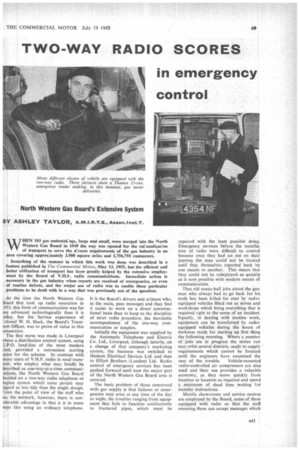TWO-WAY RADIO SCORES in emergency control
Page 71

Page 72

If you've noticed an error in this article please click here to report it so we can fix it.
WHEN 103 gas undertak'ngs, large and small, were merged !Filo the North Western Gas Board in 1949 the way was opened for the raeonalizar:on of transport to serve the d:verse requirements of the gas industry in an area covering approximately 3,900 square miles and 1,756,755 consumers.
Something of the manner in which this work was done was described in a feature published in The Commercial Motor, May 13, 1955, but the efficient and better utilization of transport has been greatly helped by the extensive employment by the Board of V.H.F. radio communications. Immediate action is necessary in the gas industry when reports are received of emergencies, or even of routine defects, and the major use of radio was to enable these particular problems to be dealt with in a way that was previously out of the question.
At the time the North Western Gas 3oard first took up radio operation in .953, this form of communication was far ess advanced technologically than it is oday, but the Service experience of 2olonel W. H. Slack. the Board's Transmrt Officer, was to prove of value in this :on nect ion.
The first move was made in Liverpool vhere a distribution control system, using land-tine of the most modern :And. provided a convenient starting mint for the scheme. In contrast with nany users of V.H.F. radio in road transmrt. who employ what may briefly be lescribed as one-way-at-a-time communi:ations, the North Western Gas Board lecided on a two-way radio telephone or luplex system which some people may egard as less tidy than the single design. ;rom the point of view of the staff who Ise the network, however, there is coniderable advantage in that it is in some vays like using an ordinary telephone. It is the Board's drivers and artisans who, in the main, pass messages and they find it easier to work on a direct conversational basis than to keep to the discipline of strict radio procedure, the inevitable accompaniment of the one-way communication or simplex.
Initially the equipment was supplied by the Automatic Telephone and Electric Co. Ltd., Liverpool, although Latterly, on a change of that company's marketing system, the business was switched to Hudson Electrical Devices Ltd. and then to Elliott Brothers (London) Ltd. Radio control of emergency services has been pushed forward until now the major part of the North Western Gas Board area is covered.
The basic problem of those concerned with gas supply is that failures or emergencies may arise at any time of the day or night, the troubles ranging from equipment that fails to function satisfactorily to fractured pipes, which must be repaired with the least possible delay. Emergency services before the installation of radio were difficult to control because once they had set out on their journey the men could not be located until they themselves reported back by one means or another. This meant that they could not be redeployed as quickly as is now possible with modern means of communication.
That old music-hall joke about the gasman who always had to go back for his tools has been killed for ever by radioequipped vehicles fitted out as stores and workshops which bring everything that is required right to the scene of an incident. Equally, in dealing with routine work, equipment can be transferred by radioequipped vehicles during the hours of darkness ready for starting up first thing the following morning, Where a number of jobs are in progress the stores van may orbit several districts, ready to supply requirements which cannot be forecast until the engineers have examined the seat of the trouble. Vehicle-mounted radio-controlled air compressors are also used and their use provides a valuable economy, as they move quickly from location to location as required and spend a minimum of dead time waiting for transfer instructions.
Mobile showrooms and service centres are employed by the Board, some of them equipped with radio so that the staff manning them can accept messages which require immediate action in the same way as the static service centre can accept complaints for onward transmission by the G.P.O. system. This is an arrangement which undoubtedly gives the consumer greater confidence in the organization.
For the senior officers radio connection has the very definite advantage that without losing touch with their offices they can orbit in the districts for which they are responsible.
The North Western Gas Board makes use of the Fuel and Power Industries, frequencies which are allocated by the G.P.O. in such a way as to eliminate so far as is practicable interference between different systems. To cover the Board's area of supply a series of base stations is necessary, that for the Manchester Group working from the Medlock Street Gasworks, whilst the Central Lancashire area, with Bury as its headquarters, operates from Birtles, near Bury. The Mersey Group has one transmitter at Wavertree, Liverpool, and another on a water tower at Prenton in the Wirral. The aerial for the South Lancashire Group is carried on a gas holder at Pocket Nook, St. Helens, whilst the North Cheshire Group aerial is mounted on top of the retort house at Denton Gasworks. West Lancashire, with administration at Preston and Blackpool, has two transmitters. One on the gas holder at Marton is linked with the control at Princess Street, Blackpool; the other is on the roof of a block of flats in PreSion, with a control at Warwick Street in the town.
At present a further transmitter is being erected on Harm!don Hill; it will be controlled by radio link from the main transmitter at Birtles in the Central Lancashire Group. This will enable officials based on Bury to control operations as far afield as Clitberoe, a radio coverage which would otherwise be impossible owing to the topographical features of the land.




















































































































